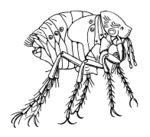Difference between revisions of "Tunga penetrans"
| (One intermediate revision by the same user not shown) | |||
| Line 1: | Line 1: | ||
| − | {{ | + | {{OpenPagesTop}} |
| − | |||
Also known as: '''''Chigger — Jigger — Chigoe — Sand flea | Also known as: '''''Chigger — Jigger — Chigoe — Sand flea | ||
{{Taxobox | {{Taxobox | ||
| Line 33: | Line 32: | ||
See [[Flea Life Cycle|general flea life cycle]]. | See [[Flea Life Cycle|general flea life cycle]]. | ||
| − | = | + | {{Learning |
| − | + | |literature search = [http://www.cabdirect.org/search.html?q=title:(%22Tunga+penetrans%22)+ ''Tunga penetrans'' publications] | |
| − | + | }} | |
| − | |||
| − | |||
| − | |||
| + | {{OpenPages}} | ||
[[Category:Fleas]] | [[Category:Fleas]] | ||
| − | |||
| − | |||
Latest revision as of 13:41, 20 July 2012
Also known as: Chigger — Jigger — Chigoe — Sand flea
| Tunga penetrans | |
|---|---|
| Class | Insecta |
| Order | Siphonaptera |
| Family | Hectopsyllidae |
| Species | Tunga penetrans |
Hosts
Humans and Pigs are the primary hosts. Reservoir hosts include: cattle, sheep, horses, mules, rats, mice, dogs and some wild animals.
Identification
T. penetrans is a parasite of the family Hectopsyllidae. The female is around 1mm, and the male is smaller at around 0.5mm in length. The thorax is rather short, and a reddy-brown in colour.
Life Cycle
The breeding female burrow into exposed skin on the feet of mammals. They remain there for around 14 days while they develop their eggs. They enter the host using their adapted mouthparts, and the female will feed on the host body fluids.
The skin surrounding the parasite will expand and swell, leaving an opening for eggs to pass, and infect the environment.
The eggs require around 3 days to hatch, and the total life cycle requires about 12 days.
| Tunga penetrans Learning Resources | |
|---|---|
 Search for recent publications via CAB Abstract (CABI log in required) |
Tunga penetrans publications |
Error in widget FBRecommend: unable to write file /var/www/wikivet.net/extensions/Widgets/compiled_templates/wrt6646a922b271c1_15425926 Error in widget google+: unable to write file /var/www/wikivet.net/extensions/Widgets/compiled_templates/wrt6646a922b5e487_11807502 Error in widget TwitterTweet: unable to write file /var/www/wikivet.net/extensions/Widgets/compiled_templates/wrt6646a922b91f39_32126725
|
| WikiVet® Introduction - Help WikiVet - Report a Problem |
